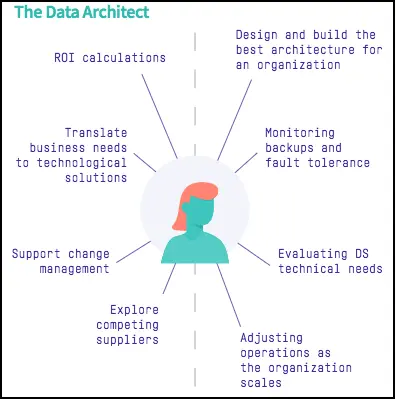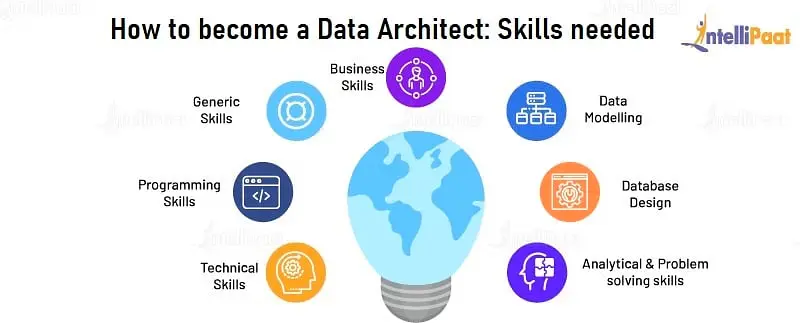How to Become a Data Architect in 2024 [Step-By-Step Guide]
- -
- Time -

As modern enterprises awaken to the game-changing influence data now wields across functions from finance to operations and customer engagement, a critical role has rapidly elevated behind the scenes – the data architect. These strategic builders collaborate with leadership, converting expansive yet disjointed data sprawls into governed digital infrastructure assets, unlocking transformation.
With Gartner estimating that global data will swell from 4 zettabytes in 2020 to 181 zettabytes by just 2025 (!), organizations require digitally savvy navigators capable of charting coherent data roadmaps. Data architects fulfill this complex mission via versatile blended skills bridging IT engineering, analytics modeling, and executive alignment talents.
The market confirms the integral value data architects provide, with the Bureau of Labor Statistics specifically forecasting 8% targeted job growth between 2020 through 2030 – a healthy clip exceeding most other technology roles. This translates into over 18,500 fresh, high-quality openings for proven performers primed to capitalize on red-hot demand.
Yet, for all the opportunity brimming, many aspiring entrants still grapple with clarifying precisely how to establish an initial foothold before ascending into enterprise data architect stardom. This definitive guide has you covered mapping the modern data architect skill terrain with actionable frameworks to sharpen your toolbox.
We’ll explore must-have proficiencies melding data infrastructure literacy with analysis finesse and analyze optimal learning. Let’s get started charting your data architect specialization game plan!
Table of Contents
- What is a Data Architect?
- What does a Data Architect do?
- Types of Data Architect Careers
- Skills Needed to Become a Data Architect
- Steps to Become a Data Architect in 2024
- Step 3: Earn Necessary Data Architect Certifications
- Data Architect Salary
- Data Architect Job Outlook
- FAQs
- Q1: What is a Data Architect?
- Q2: What educational background is needed to become a Data Architect?
- Q3: Are there specific technical skills required for a Data Architect?
- Q4: How can I gain practical experience in Data Architecture?
- Q5: Are there certifications that can help me become a Data Architect?
- Q6: What is the importance of soft skills for a Data Architect?
- Q7: Can I become a Data Architect without a background in IT or computer science?
- Q8: What are the career progression opportunities for a Data Architect?
- Q9: How do I stay updated with the latest trends in Data Architecture?
- Q10: What are the first steps I should take to start my journey to becoming a Data Architect?
- Q11: How long does it typically take to become a Data Architect?
- Q12: What industries hire Data Architects?
What is a Data Architect?
Data architects occupy a unique position straddling business priorities and technological realities. They interpret strategic objectives, assess data constraints and opportunities, and bridge the divide by engineering next-generation information architectures that empower disruption.
What does a Data Architect do?

At the core, data architects are translational figures decoding leadership vision around trends from IoT sensors to customer behavior and mapping requisite data flows to navigate from current constraints towards target state ambitions.
They consult across functions, clarify use cases, and success criteria, surface data gaps hampering objectives, and spotlight infrastructure modernization needs from cloud migrations to enterprise data warehouses to unlock transformation.
From there, data architects drill down into nitty-gritty design thinking, whiteboarding information integration plans, fusing siloed datasets into unified, analytics-ready data lakes, and introducing governance guardrails ensuring accessibility while securing sensitive information. Refining data ontology by providing common schema standards, glossaries, and access protocols also fosters cross-team alignment.
Working alongside engineering counterparts, data architects map application integrations, craft entity relationship diagrams guiding database development, configure data pipelines supporting test and production environments, and instrument monitoring requirements to uphold optimal performance. The blueprints set the foundation enabling advanced analytics downstream.
Through every phase, from ideation and specs to rollout, continuous stakeholder dialogue allows data architects to refine the vision, translating tactical adjustments to the roadmaps. Upon implementation, meticulous documentation captures operational knowledge and design decisions, crystallizing reference models to inform subsequent enhancement cycles – be it scaling for soaring data intake or pivoting to address revised business objectives.
The critical competencies spanning both the ability to understand diverse data needs and the acumen architecting modern digital realms primed to fulfill them cement why data architects have quickly become among the most influential shapers of enterprise evolution.
Types of Data Architect Careers
Here is an overview of some common data architect career paths:
Security Architects
Security architects are tasked with drawing up and rolling out robust security protocols to safeguard sensitive data. They analyze potential vulnerabilities, threats, and risks, while factoring in compliance considerations. Based on assessments, they hammer out guidelines and controls around access, encryption, rights management, network security, and incident response. As risks evolve, security architects consistently review and shore up defenses to plug gaps.
Cloud Architects
Cloud architects keep pace with data regulations and legislation to ensure oversight policies are up to scratch. They monitor data flows and storage to head off escalating costs, latency issues, or maxing out capacity limits. As needs bulge, cloud architects map out and build up cloud infrastructure, while keeping complex hybrid multi-cloud environments running smoothly.
Machine Learning Architects
Machine learning architects construct and scale out durable big data pipelines to feed data to AI systems. They tee up and optimize data sets to train machine learning models that drive automation and analytics. As models are rolled out, they closely track model drift or degradation in performance, iterate improvements, and phase in upgrades.
Information Architects
Information architects chart out intuitive, consistent information blueprints tailored to various consumer types. They shape information hierarchies and points of access to amplify usability and findability. As firms put out new digital products and platforms, information architects sweep in to re-map structures and navigation for seamless user experiences.
Database Architects
Database architects engineer custom database ecosystems capable of handling seismic business growth and evolution. They strategize roadmaps of databases and data marts to underpin new products, emerging technologies, mergers, geographic expansion, and other dynamic strategic shifts in the future data landscape.
Skills Needed to Become a Data Architect

Listed below are the essential skills of a data architect:
Technical Skills for Data Architects
- Data architects need to master both relational and non-relational databases to build resilient and scalable data infrastructure. They model structured relational databases and may also design NoSQL databases that handle unstructured or semi-structured data from new sources.
- They are well-versed in data warehousing disciplines to carry out enterprise data processing and analytics. This entails skills to architect warehouses, construct ETL data pipelines to bring together disparate data sets and enable business intelligence through online analytical processing.
- Data architects stay on top of prevalent application server frameworks and database management systems that companies run on, such as Oracle, Microsoft SQL Server, and IBM DB2. They tap into these backend technologies to drive database functionality and connectivity.
- With a user interface and query languages like SQL, data architects smooth out and widen user access to organizational data assets through intuitive portals, dashboards, and reporting tools.
- They also grapple with enterprise application integration using intermediary technologies like message brokers and XML to get assorted applications, old and new, to interface and exchange data hand in hand.
- Agile fluency allows data architects to iteratively evolve data infrastructure in alignment with shifting business requirements.
- Data modeling proficiency in tools like ERWin enables architects to map out logical and physical data environments. Data modeling languages help communicate intricate database schemas and processes to stakeholders.
- ETL tool expertise allows the pipelining processes that consolidate data from multiple sources into warehouses and data lakes while optimizing transformations and data integrity along the way.
- As data infrastructure grows vastly complex, skills in Python, Perl, and C++ enable data architects to develop custom scripts and programs for systems integration and automation. Most leverage cloud platforms like Azure, AWS, and GCP to build out distributed database systems at scale as well.
- Finally, big data management using Hadoop-based clusters is now mainstream for cost-efficient storage and high-volume analytical workloads. Data architects draw up and tier these diversified environments using the optimal data platforms and tools for an organization’s varied needs.
Non-technical Skills for Data Architects
- Communication abilities are vital for data architects to team up with business and technology units across organizations. They need to articulate complex data infrastructure plans, explain technical specifications simply, and actively listen and respond to various needs and perspectives. This allows data architects to draw others onside to back major data initiatives, as well as pick up early warnings of emerging data issues or misalignments.
- Analytical and problem-solving prowess helps data architects contend with intricate data challenges around governance, quality, security, integrity, and accessibility. By reviewing data schemas, flows, and policies thoroughly, they can pinpoint and patch up vulnerabilities, bottlenecks, or gaps that hamper data utility.
- Juggling numerous concurrent projects calls for stellar organizational abilities and time management. Data architects map out realistic roadmaps, check in on progress systematically, adjust priorities adroitly, and meet critical deadlines while keeping key stakeholders filled in.
- Data architects often spearhead or coordinate organizational change efforts linked to data strategy and integration projects. Drawing on program management approaches, they assess potential impacts, chalk out staged plans, pull together the right resources, and steer progress carefully toward the finish line.
- Business analysis skills help data architects size up use cases and processes to uncover data-related improvements. Applying techniques like data flow or ROI analysis helps them demonstrate and win buy-in for high-value data investments. Plus, thinking strategically about overarching business goals helps position data analytics, integration, and governance initiatives to catapult future capabilities and competitive edge.
- Finally, well-honed leadership and teamwork abilities enable data architects to rally diverse teams toward common data goals. Savvy relationship-building, motivational, and presentation skills also allow them to get various stakeholders on the same data page. Together, these well-rounded technical and soft skills empower data architects to pull their weight as linchpins in data-mature organizations.
Steps to Become a Data Architect in 2024
Here is a detailed step-by-step guide to becoming a data architect in 2024:
Step 1: Obtain your Undergraduate Degree
The first step to securing a data architect role is getting a bachelor’s degree, ideally in computer science, computer engineering, or information technology. This lays the foundation for core subjects like:
Application Design: Covering topics from planning technical architectures to mapping out component interactions to crafting intuitive user experiences. Students can expect to sketch out and develop sample programs.
Systems Development: Spanning system analysis, programming languages, debugging, testing, and deployment methodologies required to build applications. Projects help tie theory to practice.
Information Management: With a focus on data storage structures, database management, data modeling standards, and governance protocols surrounding security, privacy, and lifecycle management.
Coursework also dives into computer programming languages to equip learners to code tools and scripts, web development frameworks to assemble digital products and user interfaces, operating systems to grasp how software interacts with hardware, systems analysis techniques to methodically map program specifications and interactions, and technology architecture principles to piece together complete tech stacks.
This well-rounded foundation churns out adaptable graduates equipped to dig into the nuances across the data architecture landscape in their careers ahead. Before long, they can start scoping out data infrastructure needs, mapping out flowcharts to untangle convoluted systems, and hammering out technical prototypes to bring product ideas to life.
Step 2:
Build the Right Skill Set
After getting a solid educational base, aspiring data architects should focus on developing specialized technical and business skills crucial for the role through hands-on practice.
Database Design Skills: Brush up expertise in relational databases and increasingly in NoSQL databases as well as architect robust data storage, processing, and access frameworks tailored to evolving analytical needs.
Machine Learning Skills: Gain fluency with ML algorithms, frameworks, and model building to infuse predictive intelligence into data platforms and drive everything from personalization to forecasting use cases.
Data Modeling & Visualization Skills: Learn techniques to structure, map, and illustrate intricate data relationship diagrams, entity models, data flows, hierarchies, and processing logic in intuitive ways for stakeholders.
Project Management Skills: Master coordinating collaborative enterprise data activities encompassing planning, Design, testing, change management, risk mitigation, and measuring outcomes.
Programming Languages: Attain proficiency in languages like Python, Java, C++, and Perl to develop custom scripts and programs ranging from ETL processes to analytics applications.
Operating Systems: Stay up-to-date with widely used systems like Unix, Linux, and Windows that underpin how database servers store, process, and transport data.
Business Analytics Skills: Glean expertise in BI tools and SQL to analyze data and uncover operational insights for fact-based business planning and decision-making.
By diving into real-world individual or group projects, professionals looking to pivot into data architecture roles can steadily showcase relevant mastery in diverse areas. This helps position them to architect end-to-end data solutions that serve core business requirements now and in the future.
Step 3: Earn Necessary Data Architect Certifications
With relevant skills sharpened, aspiring data architects should double down on credentials that validate their readiness to orchestrate complex data environments. Some widely recognized certifications to consider include:
- AWS Certified Data Analytics: Demonstrates ability to architect AWS cloud solutions for data lakes, warehouses, and analytics pipelines. Covers security, governance, and scaling Big Data systems.
- Microsoft Azure Data Fundamentals: Checks familiarity with Azure data workloads like relational/non-relational databases, batch/streaming analytics, data lakes, and warehouses hosted on Microsoft’s trusted cloud.
- Cisco Data Center Unified Computing Design Specialist: Focuses on abilities to specify and design secure virtualized data center infrastructure leveraging Cisco UCS platforms.
The credential or combination of credentials data professionals choose to unlock depends on the technology stacks and architecture approaches an organization relies on. But broadly recognized certs build trust in one’s well-rounded data architecture skills.
Step 4: Complete an Internship
Before stepping into a data architect role, it is advisable to clock in meaningful hands-on experience through internships. These provide a low-risk environment for budding professionals to dip their toes into application architecture, network management, and performance monitoring – key pillars underpinning data infrastructure.
- Application Architecture Internships: Gain exposure to prototyping, planning, testing, and deploying various types of applications – be it mobile, web, desktop, or client-server systems. Learn techniques to assess requirements, hammer out technical specifications, put together system components, and test overall performance.
- Network Management Internships: Observe how enterprise networks tie together core infrastructure like servers, computers, storage devices, and security layers into high-speed environments accessed by employees and applications. Assist network admins in daily operations, troubleshooting, and fine-tuning tasks.
- Performance Management Internships: Shadow performance engineers as they keep close tabs on infrastructure, application, and database efficiency metrics using specialized monitoring tools. Help compile reports, trace issues slowing down critical data flows, and assist efforts to continually eke out gains.
By serving these internship stints in real-world IT settings, aspiring data architecture professionals get to build first-hand experience tackling the types of data-centric demands they will encounter in their careers ahead. This dividends them with intuitive skills to size up needs, head off pain points, and help steer optimized data solutions.
Step 5: Get Hired as a Data Architect
By early 2024, aspiring data architecture professionals will be geared up and raring to step into challenging roles, armed with technical education, diverse skillsets, recognized credentials, and internship experiences under their belt.
Many openings can be found at large enterprises across sectors like financial services, higher education, healthcare, insurance, and manufacturing that rely on the powerful combination of expansive data and analytics to unlock operational insights.
Look to slide into data architect positions at major banks or insurance agencies that hinge on harnessing real-time customer data flowing in from myriad touchpoints to personalize offerings. Educational institutions also need a robust analytics data infrastructure to glean insights from learning habits and grades to curriculum assessments for better student outcomes.
The healthcare sector likewise needs to aggregate information from patient records, scans, wearables, and more to inform diagnosis and treatment plans powered by AI assistants. And manufacturers can tap real-time sensor data from internet-connected equipment to optimize production quality and catch issues before outages occur.
Opportunities also abound at global software and hardware vendors like Microsoft, IBM, Oracle, Cisco, or Dell that require data architecture mastery to keep advancing their own cloud, analytics, and database offerings.
With the relevance of data-driven decision-making only becoming more pertinent, skilled data architects will find no shortage of avenues to ply their trade across sectors.
Data Architect Salary
As of January 2024, data architects can expect to command generous compensation packages across industries in recognition of their indispensable skills in erecting and orchestrating enterprise data environments.
According to PayScale, the average base salary for data architects currently stands at $132,214 per year. This is substantially faster than average as more organizations double down on initiatives to construct insightful data pipelines.
Leading jobs platform Glassdoor provides further validation, pegging current average base salaries for data architects at around $139,401 annually. Seasoned professionals who step into enterprise architecture or data management leadership roles can level up their earnings potential to $200,000 per year or more. Glassdoor also notes data architects garner an average of $25,000 in annual bonuses and added income streams.
As companies across the board wake up to the business imperatives of extracting value from data to guide strategy and operations, skilled data architects will continue to see their expertise and counsel sought out. With the ability to save organizations tremendous time and resources while unlocking game-changing analytics capabilities, data architects are poised to secure their standing as some of the technology industry’s highest-earning roles over the next decade.
Data Architect Job Outlook
As of Thursday, January 04, 2024, data architects continue to report high job satisfaction thanks to the dynamic nature of their roles and the wealth of stimulating challenges it presents daily. With technology and data volumes evolving at breakneck speed, the most adaptable data architects stay ahead of the curve by keeping their skills refreshed on new systems and languages constantly.
Daily, data architects are relied upon to troubleshoot and optimize existing data infrastructure critical for business operations. But they also need to blueprint longer-term data strategies aligned to how organizations aim to harness analytics and AI over the next 3-5 years as strategic levers.
It is this versatile combination of tactical firefighting and strategic visioning that makes proficient data architects so valued. Companies across industries are waking up to the fact that skilled data architects represent one of the most crucial pillars underpinning their digital transformation and data-driven ambitions.
Validating this imperative, the Bureau of Labor Statistics projects employment for data architects to swell by 9% between 2021 and 2031 – a growth pace well ahead of national averages. Despite the advanced and rapidly evolving nature of the role, demand is skyrocketing as organizations increasingly bank on data to unlock insights and efficiency gains.
So, for those intrigued by the thrill and challenge of wrangling exponentially growing data volumes into productive business solutions, a career as a data architect promises no shortage of exciting high-value opportunities in the decade ahead.
Conclusion
For both seasoned data professionals and complete newcomers to the domain alike, committing to mastering versatile data architect skills delivers outsized career dividends now through the decade ahead. As data proliferation entrenches every industry, those capable of engineering coherent information systems and governance prepared to meet enterprise demands wield tremendous value.
Yet in a complex landscape requiring both executive mindshare and technical prowess, structured learning pathways prove pivotal to competently navigate from beginner to practitioner ready for on-the-job impact. Immersive courses provide tailored launchpads to crystallize capabilities managing data modeling intricacies, security considerations, and integration puzzle pieces that set professionals up for leadership roles crafting modern analytics infrastructure.
That’s why CCS Learning Academy offers an intensive Data Architect Master Course, providing end-to-end coverage and honing in-demand abilities like data warehouse design, metadata management, data mining, reference architecture composition, and more. Taught by leading industry experts, the curriculum interweaves technical faculties and communication fluency, priming graduates to architect analytics foundations powering digital transformation wherever their career takes them.
FAQs
Q1: What is a Data Architect?
Answer: A Data Architect is a professional responsible for designing, creating, deploying, and managing an organization’s data architecture. They define how data is stored, consumed, integrated, and managed by different data entities and IT systems, ensuring that the data flows smoothly and securely between systems.
Q2: What educational background is needed to become a Data Architect?
Answer: Typically, a bachelor’s degree in computer science, information technology, or a related field is required. However, degrees in mathematics, statistics, or even business with a focus on information systems can also be relevant, especially when combined with technical experience.
Q3: Are there specific technical skills required for a Data Architect?
Answer: Yes, Data Architects need a strong foundation in database management, data modeling, and ETL processes. Proficiency in SQL, understanding of NoSQL databases, experience with cloud services like AWS, Azure, or Google Cloud, and familiarity with data warehousing solutions are also crucial.
Q4: How can I gain practical experience in Data Architecture?
Answer: Practical experience can be gained through internships, working on projects that involve database design and data modeling, contributing to open-source projects, or taking on roles that involve data management and analysis. Building and maintaining a personal database project can also provide hands-on experience.
Q5: Are there certifications that can help me become a Data Architect?
Answer: Yes, certifications such as the AWS Certified Solutions Architect, Microsoft Certified: Azure Data Engineer Associate, Google Cloud Professional Data Engineer, and IBM Certified Data Architect can bolster your credentials and demonstrate your expertise to employers.
Q6: What is the importance of soft skills for a Data Architect?
Answer: Soft skills are crucial for Data Architects, as they often need to communicate complex ideas to non-technical stakeholders, collaborate with various departments to understand their data needs, and lead teams to implement data strategies effectively.
Q7: Can I become a Data Architect without a background in IT or computer science?
Answer: While challenging, it is possible to become a Data Architect without a traditional IT or computer science background. Focusing on acquiring the necessary technical skills through courses, certifications, and practical experience, and leveraging any relevant skills from your background, can facilitate this transition.
Q8: What are the career progression opportunities for a Data Architect?
Answer: Career progression for a Data Architect can involve moving into senior or lead architect positions, specializing in areas like big data or cloud architecture, or transitioning into roles such as Chief Data Officer (CDO) or IT director, overseeing broader data strategy and governance.
Q9: How do I stay updated with the latest trends in Data Architecture?
Answer: Staying updated involves following industry news, participating in professional networks and forums, attending workshops and conferences, and continuously exploring new technologies and methodologies in data management and architecture.
Q10: What are the first steps I should take to start my journey to becoming a Data Architect?
Answer: Begin by solidifying your understanding of database systems and data modeling. Engage in self-study or formal education to learn SQL and other relevant technologies. Gain practical experience through projects or roles focused on data management, and consider pursuing certifications to validate your skills and knowledge.
Q11: How long does it typically take to become a Data Architect?
Answer: The timeline can vary widely depending on your starting point, learning pace, and the opportunities you have to gain experience. Generally, it might take several years of working in roles related to data management and analysis before transitioning into a Data Architect position.
Q12: What industries hire Data Architects?
Answer: Data Architects are in demand across a wide range of industries, including finance, healthcare, technology, retail, and government. Any organization that relies on extensive data management and analysis to inform its business practices may hire Data Architects.






